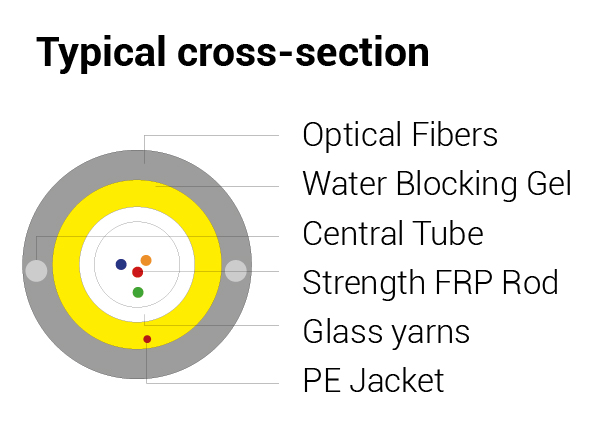Overview of Outdoor Aerial Fiber Optic Cable A-D(ZN-2PGY)2Y-XE-1.2 KN
The outdoor aerial fiber optic cable A-D(ZN-2PGY)2Y-XE-1.2 KN is specifically designed for reliable installations on telecommunication or electrical line poles, city light poles, between buildings, and other constructions. It also allows for wall-mounted applications, offering excellent durability and optimal performance in various settings.
Ideal Applications
The A-D(ZN-2PGY)2Y-XE-1.2 KN cable is designed for use in aerial installations across telecommunication and electrical infrastructure. Its UV resistance, mechanical strength, and moisture protection make it a reliable choice for data transmission in outdoor settings, offering stability, durability, and efficient installation processes.
Fiber Specifications
Single Mode Fiber G.652 D
The cable comprises 1 to 24 fibers within a central tube, which is gel-filled to provide enhanced moisture resistance and protect the fibers from external environmental influences. This ensures stable signal transmission.
Color Coding
The fibers adhere to IEC 60304 – DIN VDE0888 color coding, streamlining identification during installation, maintenance, and any required rework.
Outer Protection Features
UV-Resistant Outer Jacket
The cable is protected by a black UV-resistant polyethylene (PE) jacket. This coating provides durability against sun exposure, reducing wear over time. The jacket also features sequential meter marking, simplifying installation measurements.
Key Structural Features
- Central Tube Armoring
The cable is reinforced with two FRP (Fiber Reinforced Plastic) E.A.A coated rods, complemented by glass yarns. This structure significantly enhances its resistance to tension loads and prevents stretching, providing superior robustness. - Mechanical Resilience
The design ensures that the cable can withstand high tension and mechanical stress, maintaining performance and structure integrity.
Performance Characteristics
- Temperature Range:
- Installation: -20°C to +50°C
- Operating: -40°C to +70°C
These specifications make the cable highly adaptable for various climatic conditions.
- Bending Radius:
The cable maintains a minimum bending radius of 15 times its nominal diameter, ensuring flexibility during installation while preserving its integrity. - Mechanical Strength:
With a maximum crash resistance of 300 N/cm and a maximum tension load of 1200 N, the cable can handle demanding conditions and mechanical stress.
Mechanical Characteristics and Length
- Maximum Distance Between Poles: The cable can span up to 80 meters between poles, making it suitable for aerial installations.
- Cable Length Per Reel: Available lengths vary between 2 to 4 kilometers per reel, providing flexibility for different project requirements.




